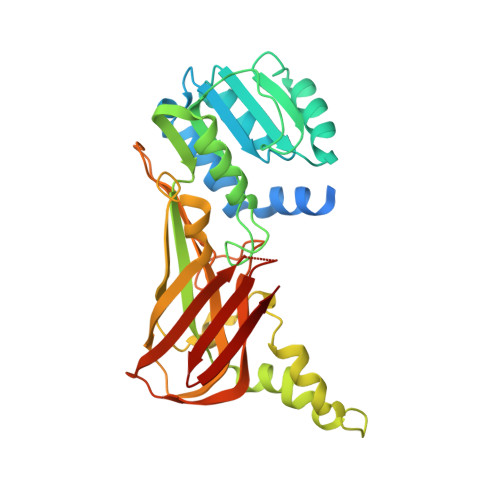Exploiting an allosteric binding site of PRMT3 yields potent and selective inhibitors.
Liu, F., Li, F., Ma, A., Dobrovetsky, E., Dong, A., Gao, C., Korboukh, I., Liu, J., Smil, D., Brown, P.J., Frye, S.V., Arrowsmith, C.H., Schapira, M., Vedadi, M., Jin, J.(2013) J Med Chem 56: 2110-2124
- PubMed: 23445220
- DOI: https://doi.org/10.1021/jm3018332
- Primary Citation of Related Structures:
4HSG - PubMed Abstract:
Protein arginine methyltransferases (PRMTs) play an important role in diverse biological processes. Among the nine known human PRMTs, PRMT3 has been implicated in ribosomal biosynthesis via asymmetric dimethylation of the 40S ribosomal protein S2 and in cancer via interaction with the DAL-1 tumor suppressor protein. However, few selective inhibitors of PRMTs have been discovered. We recently disclosed the first selective PRMT3 inhibitor, which occupies a novel allosteric binding site and is noncompetitive with both the peptide substrate and cofactor. Here we report comprehensive structure-activity relationship studies of this series, which resulted in the discovery of multiple PRMT3 inhibitors with submicromolar potencies. An X-ray crystal structure of compound 14u in complex with PRMT3 confirmed that this inhibitor occupied the same allosteric binding site as our initial lead compound. These studies provide the first experimental evidence that potent and selective inhibitors can be created by exploiting the allosteric binding site of PRMT3.
Organizational Affiliation:
Center for Integrative Chemical Biology and Drug Discovery, Division of Chemical Biology and Medicinal Chemistry, UNC Eshelman School of Pharmacy, University of North Carolina at Chapel Hill, Chapel Hill, North Carolina 27599, United States.
















